Plateonu Adarsh Nagar
Added to library: September 2, 2025

Summary
Here's a summary of the Jain text "Plateonu adarsh nagar" based on the provided pages, focusing on the essence and philosophical underpinnings as presented in the translation of Plato's Republic.
The book "Plateonu adarsh nagar" (Plato's Ideal City) is a Gujarati translation by Pranjivan Vishvanath Pathak of Plato's Republic. Published by Gujarat Vidyasabha, Ahmedabad, this edition is the second printing with 1250 copies, released in 1964 (Samvat 2020).
The introductory section (Upedhat - ઉપેાદ્ઘાત) begins by emphasizing the necessity of understanding ancient Greek philosophy to appreciate Plato's philosophy, as Plato sought to encompass the entirety of Greek thought. It traces the origins of European philosophy to Thales in the 5th century BCE, who first posed the fundamental question: "What is the fundamental element of this world?" Thales proposed water, not for the correctness of the answer but for the act of questioning itself.
The text then delves into the philosophical discussions of early Greek thinkers:
- Anaximander: Introduced the concept of "the infinite" (Apeiron) as the fundamental element, suggesting a cause that is distinct from its effects and not perceptible to the senses. He also touched upon evolutionary theories.
- Anaximenes: Proposed air as the ultimate element, perhaps as a response to the more abstract notion of the infinite.
- Heraclitus: Advocated for a philosophy of constant change, where fire is the essence of the universe. He emphasized the flux of reality, stating that one cannot step into the same river twice. His ideas of order (Logos) and strife (Eris) as the driving forces of the universe are highlighted.
- Parmenides: In contrast to Heraclitus, Parmenides argued for a static, unchanging, and indivisible reality, accessible only through pure intellect. He believed that sensory perception of change was an illusion. His student Zeno's paradoxes are mentioned as a way to illustrate the difficulties in reconciling the concepts of change and immutability.
The text notes the intellectual lineage of these ideas, tracing them through the development of Greek philosophy, and then introduces the significance of Socrates as a pivotal figure. Socrates shifted the focus from the external world to the internal world of man, emphasizing self-knowledge ("Know Thyself") and the clarity of concepts like virtue, justice, and friendship. His method of dialectic and his emphasis on virtue being knowledge are highlighted.
Plato's own philosophy is then discussed, particularly his Theory of Forms (Ideas). These Forms are described as eternal, unchanging, and pure essences that exist beyond the sensory world. Plato believed that true knowledge is of these Forms, and the physical world is merely a reflection or imitation of them. The text explains how Plato synthesized the ideas of Heraclitus (change) and Parmenides (unchanging reality) by proposing a dual existence: the world of Forms (unchanging) and the world of phenomena (changing), with the latter being imperfect copies of the former.
The summary touches upon Plato's analysis of the soul, which he divided into three parts: reason (Buddhi), spirit (Prana/Utsaha), and appetite (Kama/Vasana). The harmonious functioning of these parts, guided by reason, leads to virtue and justice. This tripartite structure is compared to the Sankhya philosophy's concept of Sattva, Rajas, and Tamas.
The book then moves into the core of Plato's Republic, outlining his ideal city-state:
- Structure: The ideal city is governed by philosopher-kings, who possess true knowledge and virtue. It is divided into three classes corresponding to the parts of the soul: the rulers (philosophers) representing reason, the auxiliaries (soldiers/guardians) representing spirit, and the producers (craftsmen/farmers) representing appetite.
- Justice: Justice in the state is achieved when each class performs its function and does not interfere with others. Similarly, justice in the individual is when the rational part rules the spirited and appetitive parts.
- Communism: To maintain the unity and prevent personal gain from corrupting the rulers and auxiliaries, Plato proposes a form of communism for these classes, abolishing private property and family structures. Children would be raised communally and their parentage kept secret.
- Education: A rigorous, lifelong education system is crucial, starting from childhood, focusing on gymnastics for the body and music (in its broader sense, including arts and literature) for the soul. The goal is to cultivate virtue, harmony, and ultimately, the knowledge of the Forms, especially the Form of the Good.
- The Form of the Good: This is the ultimate source of all truth, beauty, and knowledge, analogous to the sun illuminating the visible world. Philosopher-kings, through rigorous intellectual training, can apprehend this Form.
- Critique of Art: Plato, through Socrates, is critical of art that imitates illusions or evokes excessive emotions, believing it can corrupt the soul and lead people away from true knowledge.
The text also discusses the various forms of unjust states that are described as degenerations from the ideal republic: Timocracy, Oligarchy, Democracy, and finally, Tyranny. Each form is characterized by the dominance of a particular part of the soul or a corrupted principle, leading to societal decay and individual misery. The summary highlights the progression from a noble state to the worst state ruled by a tyrant, who is enslaved by his own desires.
The Gujarati text includes extensive footnotes and references to Western philosophers like Kant, Spinoza, and scholars like Zeller, Gomp, Adam, Taylor, Burnet, and Windelband, indicating a comprehensive academic approach. It also references the influence of Indian philosophy, particularly Sankhya and Jainism, in its discussions on the soul and ethical values. The translator, Pranjivan Vishvanath Pathak, expresses gratitude for the opportunity provided by Gujarat Vidyasabha and acknowledges the profound influence of Sri Aurobindo on his philosophical understanding.